October 17,
2015
The first
half of our Manu Biosphere Reserve tour has been so full of amazing bird
sightings it was like a tour all in its own. In the past six days we’ve descended
the moist slope of the Andes from Acjanaco Pass to Villa Carmen Biological
Station (with some light rain just part of one morning, much less than
expected) and are soon heading out by boat down the Madre de Dios River to the
lowlands where the diversity is supposed to increase. But that’s hard to
believe. We’ve already seen over 350 species of birds in less than a week.
At the
highest elevations a couple of tanager flocks finally appeared with gorgeous
Grass-green, Golden-collared, and Scarlet-bellied Mountain-Tanagers showing
well, as well as a very cooperative Black-throated Tody-Tyrant.
Close
fly-bys of two female Swallow-tailed Nightjars, a tantalizingly close calling
Rufous-banded Owl, and roosting Chestnut-collared Swifts were highlights from a
short evening walk. My attempts to rile hummingbirds with Yungas Pygmy-Owl
imitations resulted in a the real thing responding and flying in. But instead
of keeping hidden in a tree high above our heads as they often do, this one
landed amongst the lichens, bromeliads, and orchids in the trees below eye level
on the downslope side of the road where we had excellent views.
At this same elevation I was surprised to see a colorful little grass skipper. It was interesting enough that I made the uninterested group wait in the bus while I got a photo for an ID. It is Vettius coryna.
We had a
good experience watching some very active Andean Cock-of-the-rocks on their
lek, one bird being particularly bold by performing his head-bowing display on
a branch right in front of us.
The feeders
at our mid-elevation lodges of San Pedro had nice Booted Racket-tails,
Many-spotted Hummingbirds, and Violet-fronted Brilliants, but it was a resident
Wedge-billed Hummingbird that fed from the pink Heliconia flowers in the garden
that stole the show.
Other birds
in the garden were gorgeous Silver-beaked Tanager in rich light and a pair of
bold Andean Motmots (two of several that we saw) that came to feed on bananas.
Perhaps the
most astonishing and thrilling sighting from the mid-elevations was a juvenile Black-and-chestnut
Eagle that our van flushed from a low log on the side of the road. The monster
flapped slowly in front of us as we came to a sudden stop, and it perched not
10 yards from the road. A passing car threatened to flush it before we got
photos, but the bird remained nonplussed, proceeded to preen, and the driver of
the passing car even paused to point his camera phone out the window.
On our way
to the lower Kosñipata Valley we saw yet more great birds. Cinnamon-faced
Tyrannulets foraged at eye-level, a pair of Wattled Guans surprised us in trees
next to the road, and a stationary Lanceolated Monklet perched in the open but
far from obvious was brilliantly spotted by one of the participants. The
butterflies were out of this world. Some of the showier and more colorful were
the clear-winged metalmark Chorinea
sylphina and the shocking Fountainea nessus, Superb Leafwing, wings spread below a bridge over
a small stream.
The birds of
the bamboo thickets here at Villa Carmen Biological Station were amazingly
cooperative. While standing in one spot just a ten-minute walk from our rooms
we saw Bamboo Antshrike and Yellow-breasted Warbling-, Goeldi’s, White-lined,
and Manu Antbirds. White-cheeked Tody-Flycatcher was in another bamboo thicket
as well, and we ended that first day with over 130 species. Even closer to our
rooms was a family group of the most unlikely of the world’s birds, the
Hoatzin, and at the same marsh we enjoyed a tail-wagging, head-bowing, and
sac-inflating performance from a pair of Black-capped Donacobius. The overnight
thunderstorm and yesterday morning’s continuing sprinkles produced a termite
emergence that resulted in an explosion of bird activity such as a flock of a
dozen flycatching Purple Honeycreepers and three male Plum-throated Cotingas
perched in some treetops. We then watched a non-swarming column of army ants (the
orange-bodied Eciton rapax) with a
kleptoparasitic silverfish living amongst them. These ants were running quite fast in a narrow column across our trail, back and forth from their nest and whosever nest their were raiding, and we noticed a couple of these interlopers running right alongside the ants. They were even a bit faster than them, rubbing shoulders and not being attacked. It turns out they camouflage themselves with the ants' own odors while sneaking meals right out from under the ants' noses.
Later in
the afternoon a great surprise and first local record was an Upland Sandpiper
in a newly planted field in the agricultural plots that are part of the
station’s involvement in helping the communities of the region develop
sustainable farming methods.
We missed seeing the adult Common Potoo that had
been on a nest, but in its place instead was the most adorable half-grown chick
roosting on its own, trying its best to look like a tree trunk.

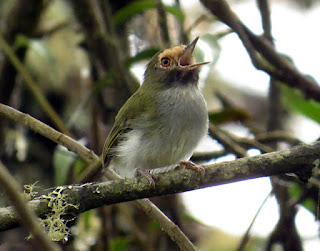

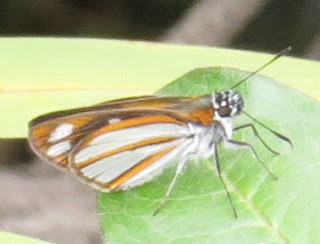

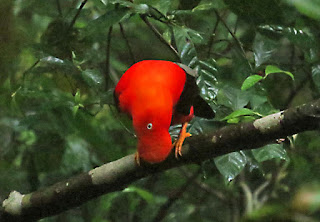
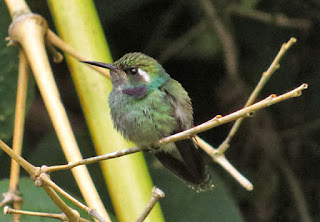



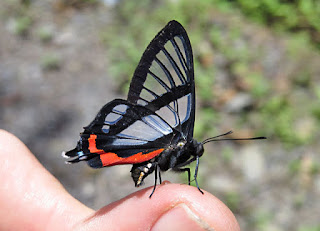
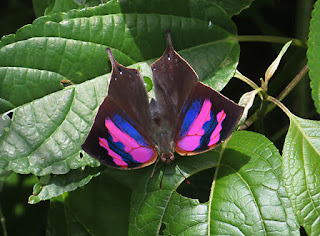
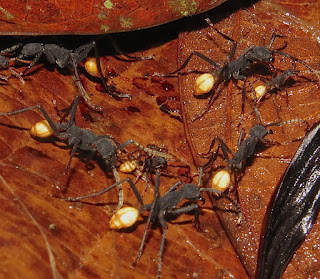









No comments:
Post a Comment